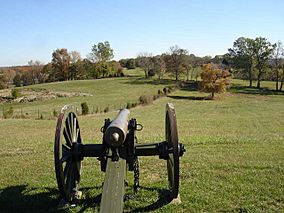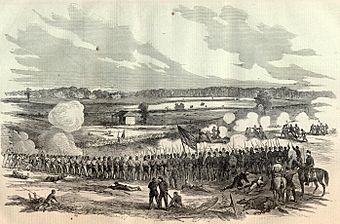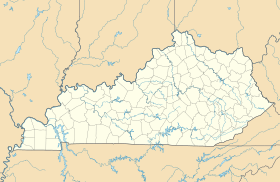Perryville Battlefield State Historic Site facts for kids
Quick facts for kids Perryville Battlefield State Historic Site |
|
|---|---|

View from Parsons battery position on the Open Knob
|
|
| Location | Boyle County, Kentucky, United States |
| Area | 745 acres (301 ha) |
| Elevation | 860 ft (260 m) |
| Established | 1936 |
| Administrator | Kentucky Department of Parks |
|
Perryville Battlefield
|
|

The Battle of Perryville
as depicted in Harper's Weekly |
|
| Lua error in Module:Location_map at line 420: attempt to index field 'wikibase' (a nil value). | |
| Location | Boyle County, Kentucky |
| Nearest city | Perryville, Kentucky |
| Area | 2,500 acres (1,000 ha) |
| Built | 1862 |
| NRHP reference No. | 66000356 |
| Added to NRHP | October 15, 1966 |
The Perryville Battlefield State Historic Site is a special park in Kentucky. It covers about 745 acres (which is like 564 football fields!). This park is near the town of Perryville, Kentucky. It helps us remember an important event from the American Civil War.
The park is still growing! Groups like the Kentucky Heritage Land Conservation Fund and the American Battlefield Trust buy more land. This helps protect more of the historic battlefield. At the site, you can visit a museum. It tells the story of the Battle of Perryville. Many Confederate soldiers who died there were buried nearby. You will also see monuments, signs, and cannons. These mark important spots from the battle. The site became a Kentucky State Park in 1936.
Contents
The Battle of Perryville: A Key Civil War Moment
The Battle of Perryville was a big fight during the American Civil War. It happened on October 8, 1862. This battle was between two sides. One side was the U.S. Army of the Ohio. It was led by Don Carlos Buell. The other side was the Confederate Army of Mississippi. This army was led by Braxton Bragg.
Why the Battle Was Important
The Confederates won the actual fight that day. This is called a "tactical victory." But the United States won in the long run. This is known as a "strategic victory." After the battle, General Bragg pulled his army out of Kentucky. This meant Kentucky stayed under U.S. control for the rest of the war.
Life During and After the Battle
The battle caused a lot of damage to homes and farms in Perryville. Local families lost food and supplies. Their buildings were often used as hospitals for wounded soldiers. One farmer, Henry P. Bottom, saw his farm badly damaged. A large barn full of hay burned down from artillery fire. Many people in the area faced similar losses.
Remembering the Fallen Soldiers
Many soldiers died during the battle. The U.S. Army buried most of their dead quickly. They dug long trenches. But many Confederate soldiers remained unburied for a week. Local people helped U.S. soldiers bury the dead in shallow graves. Later, in 1886, 435 Confederate soldiers were buried in a special cemetery on Henry Bottom's land. Only one headstone from that time remains today. It belongs to Samuel H. Ransom.
After the war ended in 1865, the U.S. Army reburied 969 U.S. soldiers. They created a national cemetery at Perryville. However, this cemetery was later closed in 1867. The U.S. soldiers were moved to Camp Nelson National Cemetery in Jessamine County, Kentucky. This means no identified U.S. soldiers are buried at the Perryville battlefield today.
Honoring the Past: Memorials and Preservation
Years after the battle, people wanted to remember what happened. In 1902, a monument for Confederate soldiers was placed in their cemetery. Later, in 1931, a smaller memorial for U.S. soldiers was built nearby.
Creating the Historic Site
The Perryville State Battlefield site was officially created in 1954. This was done by the Kentucky State Conservation Commission. On the battle's 100th anniversary in 1962, a museum and visitor center opened. These help people learn about the battle.
Growing Appreciation for Western Battles
For a long time, battles fought in the Western Theater of the American Civil War were not as well-known. People often focused more on battles in the Eastern Theater, especially in Virginia. But in recent years, historians have worked to show how important these Western campaigns were. Now, more people understand the significance of battles like Perryville. They also appreciate other battlefields in Kentucky, Tennessee, and Mississippi.
Expanding the Park and Protecting History
The Perryville battlefield was recognized as a National Historic Landmark in 1960. It gets about 7,000 visitors each year. The park has grown a lot. For example, 149 acres of farmland were bought from a descendant of Henry Bottom. This more than doubled the park's size. It also lets visitors explore more of the battlefield. The American Battlefield Trust and its partners have helped save over 1,200 acres at Perryville. Much of this land has become part of the state park. This helps protect this important piece of history for everyone.





